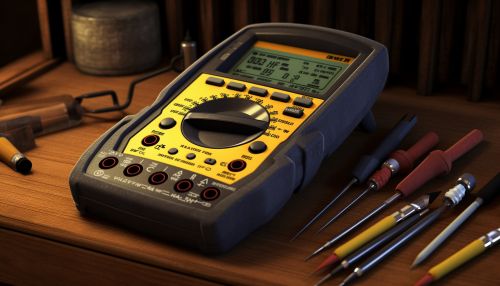Multimeter
Introduction
A multimeter is a versatile instrument used in electronics to measure various parameters such as voltage, current, and resistance. It is an essential tool in the field of electronics and electrical engineering, providing accurate and reliable measurements.


History
The first multimeter was invented in the early 1920s by British Post Office engineer, Donald Macadie. He named it an 'Avometer', a combination of the words 'Ampere', 'Volt' and 'Ohm', the three basic units of electrical measurement.
Types of Multimeters
There are two main types of multimeters - analog and digital.
Analog Multimeters
Analog multimeters are the earliest type of multimeter, they use a moving needle to display measurements. Despite the advent of digital multimeters, analog multimeters are still in use due to their ability to measure rapidly varying values.
Digital Multimeters
Digital multimeters (DMMs) are the most common type of multimeter today. They provide digital readouts, making them easier to read and more accurate than their analog counterparts.
Components of a Multimeter
A multimeter consists of several components, each with a specific function.
Display
The display is where the measurement readouts are shown. In digital multimeters, this is typically a liquid crystal display (LCD).
Selection Knob
The selection knob allows the user to choose the function and range of the measurement.
Ports
Multimeters have several ports into which the test leads are inserted. The common ones are the COM (common) port, the VΩmA port (for voltage, resistance, and low current measurements), and the 10A port (for high current measurements).
Test Leads
Test leads are wires with probe tips used to connect the multimeter to the device under test.
Functions of a Multimeter
Multimeters are used to measure a variety of electrical parameters.
Voltage Measurement
Multimeters can measure both AC and DC voltages. The multimeter is connected in parallel to the circuit element to measure voltage.
Current Measurement
To measure current, the multimeter is connected in series with the circuit. Multimeters can measure both AC and DC currents.
Resistance Measurement
Resistance is measured by applying a small voltage to a circuit and measuring the current flowing through it.
Continuity Test
A continuity test checks if a circuit is complete by sending a very small amount of current through the circuit.
Diode Test
A diode test checks whether a diode is functioning properly by sending a current through the diode and measuring the voltage drop.
Safety Precautions
When using a multimeter, certain safety precautions should be observed to prevent electrical shock and damage to the multimeter.
- Always start with the highest range when measuring. - Never touch the probes' metal tips while measuring. - Always disconnect the live test probe before the neutral one. - Never use the multimeter if the multimeter or test leads look damaged. - Always use a multimeter that is rated for the category and voltage level you plan to measure.
